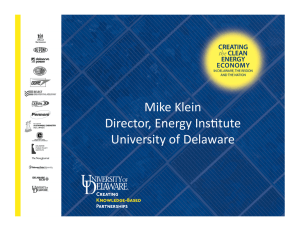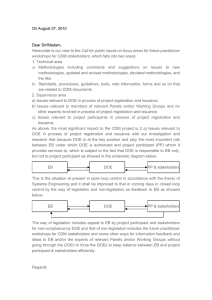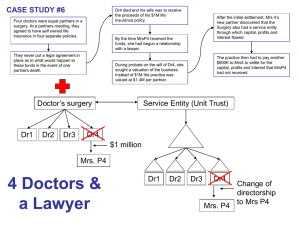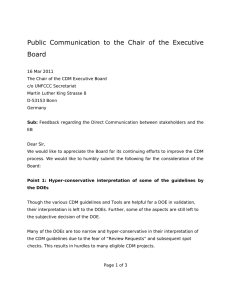Comments on “
advertisement
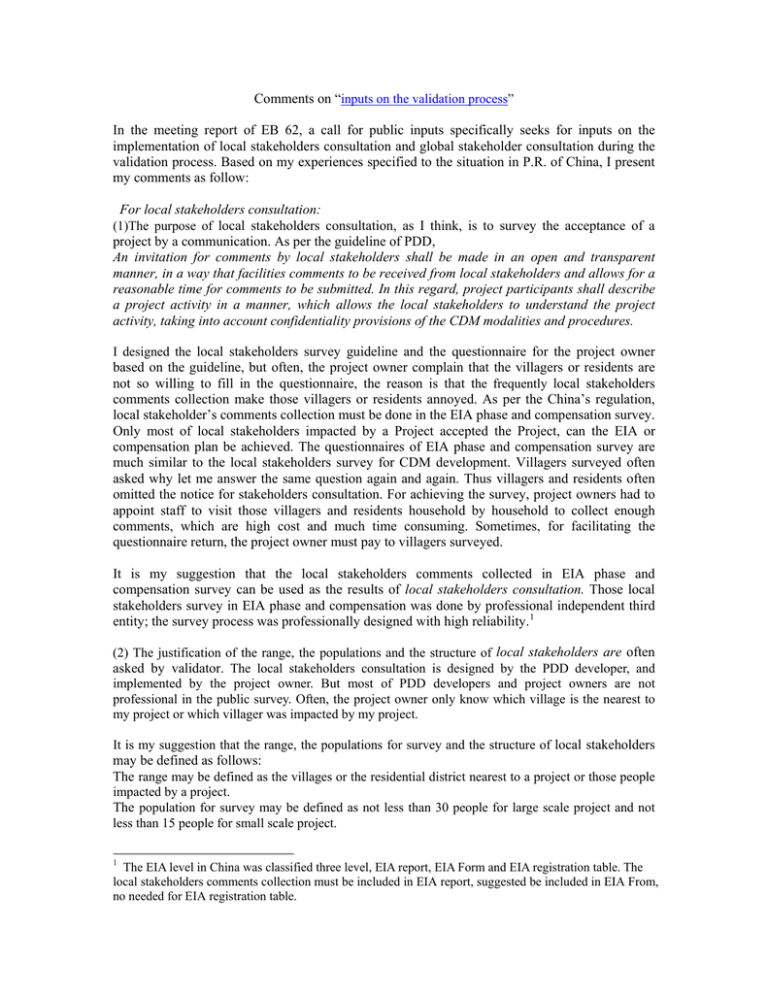
Comments on “inputs on the validation process” In the meeting report of EB 62, a call for public inputs specifically seeks for inputs on the implementation of local stakeholders consultation and global stakeholder consultation during the validation process. Based on my experiences specified to the situation in P.R. of China, I present my comments as follow: For local stakeholders consultation: (1)The purpose of local stakeholders consultation, as I think, is to survey the acceptance of a project by a communication. As per the guideline of PDD, An invitation for comments by local stakeholders shall be made in an open and transparent manner, in a way that facilities comments to be received from local stakeholders and allows for a reasonable time for comments to be submitted. In this regard, project participants shall describe a project activity in a manner, which allows the local stakeholders to understand the project activity, taking into account confidentiality provisions of the CDM modalities and procedures. I designed the local stakeholders survey guideline and the questionnaire for the project owner based on the guideline, but often, the project owner complain that the villagers or residents are not so willing to fill in the questionnaire, the reason is that the frequently local stakeholders comments collection make those villagers or residents annoyed. As per the China’s regulation, local stakeholder’s comments collection must be done in the EIA phase and compensation survey. Only most of local stakeholders impacted by a Project accepted the Project, can the EIA or compensation plan be achieved. The questionnaires of EIA phase and compensation survey are much similar to the local stakeholders survey for CDM development. Villagers surveyed often asked why let me answer the same question again and again. Thus villagers and residents often omitted the notice for stakeholders consultation. For achieving the survey, project owners had to appoint staff to visit those villagers and residents household by household to collect enough comments, which are high cost and much time consuming. Sometimes, for facilitating the questionnaire return, the project owner must pay to villagers surveyed. It is my suggestion that the local stakeholders comments collected in EIA phase and compensation survey can be used as the results of local stakeholders consultation. Those local stakeholders survey in EIA phase and compensation was done by professional independent third entity; the survey process was professionally designed with high reliability. 1 (2) The justification of the range, the populations and the structure of local stakeholders are often asked by validator. The local stakeholders consultation is designed by the PDD developer, and implemented by the project owner. But most of PDD developers and project owners are not professional in the public survey. Often, the project owner only know which village is the nearest to my project or which villager was impacted by my project. It is my suggestion that the range, the populations for survey and the structure of local stakeholders may be defined as follows: The range may be defined as the villages or the residential district nearest to a project or those people impacted by a project. The population for survey may be defined as not less than 30 people for large scale project and not less than 15 people for small scale project. 1 The EIA level in China was classified three level, EIA report, EIA Form and EIA registration table. The local stakeholders comments collection must be included in EIA report, suggested be included in EIA From, no needed for EIA registration table. The structure for survey may be defined as the gender proportion, such as the female proportion will be not lower than 15%. I think the gender structure is enough, because the mobility of adults, such as go out for work, which often makes the age structure and the education structure deviated. For global stakeholders consultation: (1) It is my suggestion that the commenter must be certified by EB to avoid baleful comments. Recently, some commenters make the same comment for many projects, no matter what type of the Project is. A commenter, named zhong zhou li, made the same comment to more than 60 projects of China under validation from 15/04/2011 to 15/06/2011, including windpower, hydropower, raw material replacement, WHR, household biogas etc. His comment is as follow: -------------------------------------------------------------------------------It is evident from the PDD that the values are consistent and it is definitely forged and cooked up values to show a non CDM project as a CDM project. What is this? DoE to check the Detailed Project Report and Feasibility Report which is submitted to the other agencies and Banks by Project owner and ensure that the values match with the DPR/FR submitted to DoE also. After careful study of PDD it is found that DPR/FR is in different versions made and submitted with different purposes to different agencies which is totally unacceptable, illegal and unethical. PP/Consultant may show some undertaking letter from bank manager to DoE stating that both DPR’s are same. These kinds of letters should not be accepted and entertained by DoE. While collecting the DPR/FR from banks and other agencies, all DPR/FR pages should be counter signed by Banks and other agencies so that the real DPR/FR given to other parties by the PP/Consultant is same as the one submitted to DOE. In this particular project there is clear cut evidence that DPR/FR values are changed/ fabricated mischievously and intentionally. This must be probed fully. DOE must take a written undertaking from the PP/Consultant about the list of parties to whom this DPR/FR is submitted and for what purposes. Then DOE should cross check with all the parties and confirm that the same DPR/FR is submitted to all the parties correctly without any changes. DOE must not accept any reports and undertakings from PP/Consultant. DOE must make independent evaluation and use totally different parties without informing the PP or Consultant to cross check the facts. DOE to write to the party who prepared the DPR/FR which is submitted to the banks and other agencies and the same is verified against the one submitted to the DOE by PP/Consultant. This project is a fabricated and fake CDM project and must be rejected by the DOE right away. DOE should not support this kind of projects otherwise CDM EB should suspend this DOE for at least one year. Submitted by: zhong zhou li -------------------------------------------------------------------------------Here I take the comment to show what means baleful: (I) “After careful study of PDD it is found that DPR/FR is in different versions made and submitted with different purposes to different agencies which is totally unacceptable, illegal and unethical. ” , The commenter is total blind to China’s regulations and procedures on project development. As per China’s regulations and procedures on project development, there included project proposal, FSR, project application report(PAR), primary designed report(PDR), detail technical design(DTR), for different purposes. Such as project proposal is for investment introduction, FSR is for investment decision (including investment cost estimation), PAR is summary of FSR for DRC officials (including investment cost estimation), PDR is the detail layout design (including investment budgetary) and can be overleaped for medium and small project, and DTR is engineering blueprints. For most of projects, DTR are not needed to be approved. For large scale hydropower project, FSR is approved by DRC, but the PDR is approved by water resource authorities. And, if the investment budgetary in PDR or the real investment is 10%-20% 2 higher than the 2 The extent was stipulated by provincial DRC and different investment estimation in the approval of the FSR, the FSR must be re-compiled and re-approved. The FSR, much like PDD in some extent, have many versions, such as draft version, submitting for technical review version, revised version after technical review, estimation cost adjust version etc. The version name was determined by the design entity. The investment decision may be based on any version of the FSR. But the estimated investment cost is determined by the version of the FSR for investment decision. The investment cost of a project must be presented in the approval of the Project, and the value is equal to the version of the FSR for investment decision, because the change of input values will result in re-investment-decision. The FSR should be revised according to new guidelines, relevant experts comments and relevant other approval such as EIA approval (a project should be approved after EIA approval was obtained, and the EIA approval and corresponding requirement should be added into the FSR). So, the conclusion “which is totally unacceptable, illegal and unethical.” from Zhong Zhou Li must be baleful. (II). Mission impossible was required by the commenter. The commenter often asked how a validator to audit a project, such as “While collecting the DPR/FR from banks and other agencies, all DPR/FR pages should be counter signed by Banks and other agencies so that the real DPR/FR given to other parties by the PP/Consultant is same as the one submitted to DOE.” But for banks and other agencies, I think the agencies means official authorities, who care the requirement from project owner or DOE? I sent emails to the Secretary for a clarification on MOC four and a half months ago, but up to now, there is still no any response. I am wondering there is no one in the Secretary care me. But I think the work efficiency of the Secretary is much higher than that of banks and other agencies in China. Those requirements in the work scope of an authority is not easy to obtain a reply, the rather that requirements beyond the work scope. By the way, the guidelines for CDM validation are stipulated by EB, not by stakeholder. (2)It is my suggestion that those comments not project-specified can be ignored, and the commenter should provided the reliable evidence for project-specified comments. (3) It is my suggestion that those comments including minatory words or sentences should be ignored. Such as “DOE should not support this kind of projects otherwise CDM EB should suspend this DOE for at least one year.” Kind regards Dr. Zheng Zhaoning Technical Director of Goldchina Consultancy International Co., Ltd.

